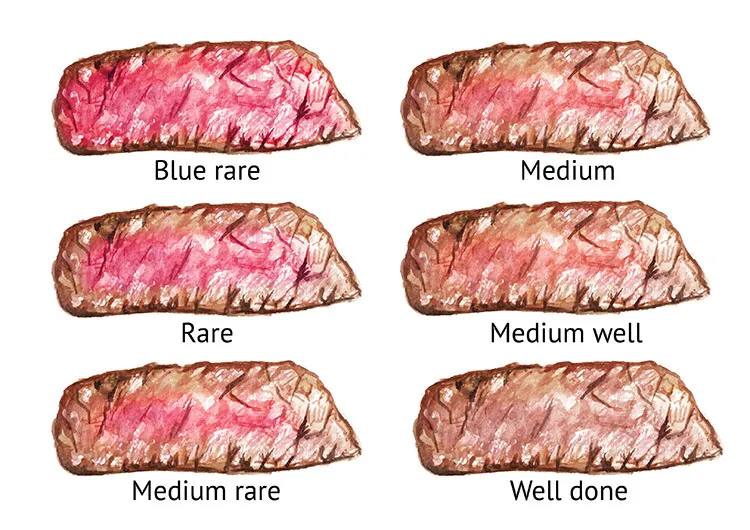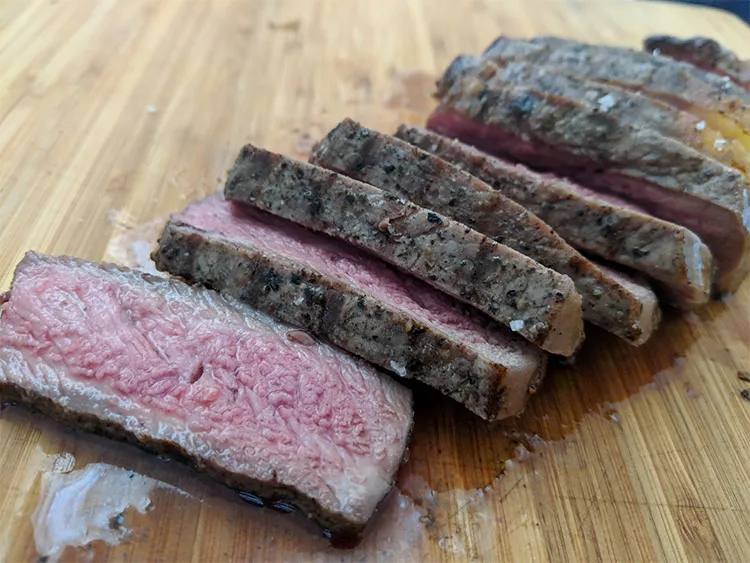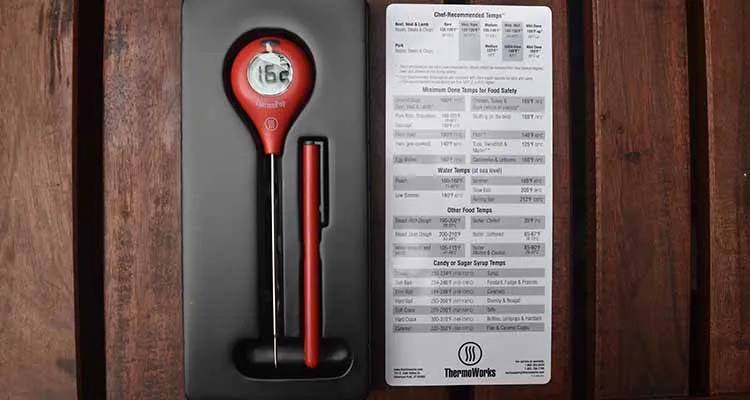A prime steak, cooked to perfection, is the king of meats.
But there’s a fine line between a beautifully grilled steak and an overcooked piece of beef-flavored rubber.
Part of the problem, especially for newer grillmasters, is the vast range of conflicting advice on how to tell if your steak is cooked correctly.
Do you use the finger test? What about the palm test, the face test, a meat thermometer, cutting the steak open, or none of the above?
To bring a little clarity, we’re breaking down how to cook a steak to your desired doneness, what each level of doneness looks like, and why some of the conventional wisdom on cooking a steak isn’t all that wise.
What are the different degrees of steak doneness?
You’ve probably heard terms like “medium rare” and “well done” to describe how people like their steak cooked.
There are actually six widely established levels of steak doneness which you can ask for when ordering at a steak house.

- Blue Rare (115°F): A blue rare steak is seared on the outside, to brown the meat without significantly cooking the inside. Blue steaks are so fresh they said to have only just “stopped mooing”. The beef inside hasn’t undergone the protein breakdown of longer cooking, so it tends to be slightly chewy.
- Rare (120°F): A rare steak should have a cool, bright red, center, browned outside and the meat should be almost as soft and springy as raw meat. Rare is an excellent choice for leaner steak cuts, like tenderloins. This is because the cooking process is so fast it doesn’t have time to melt all the fat in the meat.
- Medium Rare (130°F) The most popular level of doneness, the medium-rare steak should have a warm center with a nice brown crust on the outside. The meat should be pink with a hint of red in the middle. Medium rare is a good choice for slightly fattier steaks like the ribeye because the longer cooking time renders that fat down. The rendered fat adds flavor and gives your steak a buttery smooth texture.
- Medium (140°F): A medium steak loses its hint of red, and the meat should be pink and firm all the way through. The longer cooking time of a medium steak evaporates more of the water, making the steak drier and the meat less tender.
- Medium Well (150°F) A medium-well steak might still have a little hint of pink in the center, but most of the water has evaporated, and some of the fat has started to leak out. Medium well is generally the point where the meat becomes a little too dry for most steak lovers. Very fatty steaks usually survive this process a bit better than leaner cuts.
- Well Done (160°F): Also known as the “Chef’s bane,” the well-done steak has had all the water, and most of the fat evaporated out of it, leaving the meat dry and tough. Cooking a well-done steak takes a slightly different process. To avoid burning the outside, you’ll need to cook a well-done steak slow and low for about 10 and 12 minutes per side.
The right level of doneness depends on your personal taste, with most chefs and steak enthusiasts preferring rare to medium-rare steak. However, in some countries, raw beef dishes are considered a delicacy as well.
I don’t want to eat a bloody steak!
Well, good news! The red stuff you see oozing out of your steak isn’t blood.
This is a common misconception that causes people to overcook their steak.
Nearly all of an animal’s blood is removed during the slaughtering process. The red liquid you see coming from a cooked steak is a protein called Myoglobin which is responsible for carrying oxygen through the muscle and contains a red pigment.

As the steak is cooked the myoglobin naturally darkens which is why well done steak has a depressing gray color.
Actual blood has a bitter coppery taste and quickly coagulates after an animal dies, turning thick and black. Myoglobin is a by-product of the cooking process and is thin and flavorful.
You can still order your steak “bloody” just know that you aren’t actually biting into any bloody meat.
Avoid the USDA recommendation for steak
If you know your food safety you may remember that the USDA Safe Minimum Internal Temperature Chart recommends that you cook your beef to a minimum of 145°F.
As you can see from our doneness guide, that is a recipe for medium well and pretty much nothing else.
This is because the USDA is concerned with bacteria, not flavor and 145°F is sufficient temperature to ensure a piece of meat is bacteria-free.
So, is rare steak unsafe?
Well, no. As Harold McGee, a food scientist over at the Food Network points out:
“Not if the cut is an intact piece of healthy muscle tissue, like a steak or chop, and its surface has been thoroughly cooked: bacteria are on the meat surfaces, not inside.”
Harold McGee – Food Network
Since you’ll be heating your cooking surface nice and hot to get that all-important Maillard reaction anyway, you shouldn’t be worried about the health implications of eating juicy, pink/red meat.
How to cook a steak to your desired doneness
Before we start looking at steak cooking techniques, it’s essential to understand precisely what cooking does to your steak.
Once you understand the cooking process, you can tinker with it to get the results you really want. Remember, knowledge is power, or in this case, flavor.
If you want a guide on how we recommend cooking steak, check out our reverse sear steak recipe.
What happens to your steak while it’s cooking?
According to the great minds over at the Chicago Steak Company, getting your steak just right is a two-part process:
1. Cooking
The first part is the actual cooking of the meat, where you are bringing your steak up to a consistent internal temperature. What exactly happens when you cook meat depends on how you do it, but most cooking methods have three things in common:
- Breaking down protein – Cooking meat breaks down the usually tightly wound muscle proteins. This process is called denaturing, and the breakdown of these proteins is the reason that a rare steak is generally chewier than one cooked medium-rare.
- Removing water – Mammals are mostly water, and around 75% of your steak’s muscle fibers are made up of it. During the cooking process that water evaporates, shrinking and drying out the meat.
- Melting the fat – As your steak cooks, the fat pockets in the meat melt and are absorbed into the meat, increasing its flavor. The reason that marbling is so prized in a steak is because of the flavor it imparts during the cooking process.
2. Searing
The second part of the process is searing the meat. This involves exposing the outside of your steak to extremely high temperatures for a short period of time. This sudden burst of heat causes the Maillard reaction.
The Maillard reaction browns the meat and increases the flavor by evaporating water and rearranging your steak’s sugars and amino acids.
You’ll need to bring your cooking surface up to a high temperature to cause the Maillard reaction, between 300 and 500°F.
Adam Savage of MythBusters fame teamed up with J. Kenji López-Alt from SeriousEats.com to test out the best way to sear a steak.https://youtube.com/embed/JB1x0O-bhrw?feature=oembed&enablejsapi=1&origin=https://www.smokedbbqsource.com
The video is over half an hour-long, but they do show that extreme temperature isn’t actually the best way to sear a steak.
How to know when your steak is done
As you’ve probably guessed by now, the key to understanding exactly when your steak is done is its internal temperature. Because of this, one of the most important pieces of equipment a pitmaster can have is an instant-read thermometer.

Remember, the difference between most of the steak doneness levels is between 5 and 10°F.
These small variations in temperature can be hugely challenging to measure with just your fingers and can make a real difference to your steak.
Can I tell by the color of the meat?
No, not really.
The cooking process doesn’t stop when you take your steak off the heat. That’s why we recommend you cook to 5-10°F below your target temperature. This means the color of a freshly cooked steak can change by the time you get it to the table.
Lots of things can affect the color of cooked meat, from the breed and cut of your steak to what lightbulbs you use, so it’s not a great idea to go by eye alone.
Avoid the finger test to check steak doneness
Checking your level of steak doneness by comparing it to a part of your body, like your hand or face, is one of those stubborn food myths that won’t go away.
The reality is that your hand and face aren’t the same as anyone else’s. This makes them a terrible way to measure just about anything.
If you cook a lot of steak you can definitely develop a good sense for when it’s cooked, but your hand is not accurate enough to tell the difference between rare and medium rare with any reliability.
If you want to ensure you are cooking your steak to precisely the level of doneness you require, stop poking yourself in the face and invest in a good instant thermometer.
We are fans of the Thermapen MK4 but if the price tag puts you off the same company makes a much more affordable meat thermometer that’s almost as good called the ThermoPop.

It will make knowing when your steak is cooked much a whole lot easier.
Tip – Take your steak off the heat early to avoid over cooking it
As you can see, temperature is key to getting your steak cooked to the level of doneness you really want. Another vital thing to keep in mind is that your steak does not immediately stop cooking the moment you take it off the grill.
After you stop the cooking process, the temperature of your meat will continue to rise. To avoid overshooting, it’s best to take your steak off the heat when it is around 5°F below your target temperature.
You can let your steak rest for a few minutes and the internal temperature will climb those last 5°F on its own.
This isn’t as important as most people believe, but I find that I normally let my steak rest a few minutes while I’m plating up and getting everything ready.
And if you end up cooking too much steak, we have a whole post dedicated to the safest way of storing a cooked steak.
Cook to temperature, not to touch
Cooking several steaks to different levels of doneness for a picky crowd is one of the hardest things for a grillmaster to get right.
Trying to measure that level of doneness by jabbing your steak with a finger, or comparing it to your face, is only going to make that harder.
If you want your steak done just right, invest in an instant thermometer. Your steaks will be the better for it, and you’ll burn your fingers less.